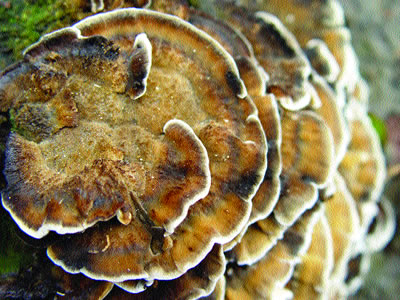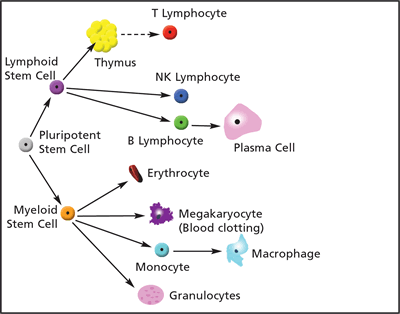Positive Health Online
Your Country

Medicinal Mushrooms - The New Addition to Western Herbal Medicine
listed in herbal medicine, originally published in issue 137 - July 2007

Coriolus mushroom
Medicinal fungi have been used for millennia in the traditional medical practices of the Orient. So revered were these fungi that their usage was often exclusively retained for the Emperor and aristocracy. Fungus such as Ganoderma lucidum (Reishi, Ling Zhi) were believed to be an elixir of life, capable of doubling one’s life span and warding off all disease and the ageing process. Over the past 30 years the west has become aware of these powerful healing tools, and they have become some of the most widely and vigorously researched natural products to date, finding their way into conventional medical treatments. This volume of attention has arisen in response to continued findings that they may be profound allies in some of today’s gravest diseases. The most important being those where the immune system is involved.
Research has indicated time and time again that medicinal mushrooms are able to instigate a stimulatory effect on various branches of the immune system. The early research on these fungi revealed that their polysaccharide content was responsible for this stimulatory action. These large branch-chained sugar molecules are also known to be present in the widely used immune tonics Echinacea spp and Astragulus membranaceus. The most widely distributed polysaccharides in medicinal fungi, and certainly the most widely studied, are the Beta-glucans. It is theorized that these molecules are very similar in structure to membrane bound polysaccharides of various cellular pathogens and, as a result, dupe the immune system into instigating a response. In the late 1980s, the Japanese mycologist Hiraoki Nanba discovered that the mushroom Grifola frondosa (Maitake) was capable of delivering the strongest stimulatory response. It was later found that this was due to maitake having a uniquely shaped polysaccharide, and this was particularly active when given in oral dosages – very useful to the modern day Herbalist and Nutritionist. It is interesting to note, however, that these polysaccharides are in fact too large and dense to be absorbed by the gut! It is believed, therefore, that these substances may be active by interacting with the white cell dense lymphatic tissue known as peyers patches within the gut, causing an alarm response, then cascade reaction and instigating a specific immune response systemically.[1] In light of Nanba’s research, fungal polysaccharides were heavily studied, and many were patented and developed into pharmaceutical drugs. The most famous of these is PSK, extracted from the Coriolus versicolor (turkey tail) mushroom, which was used in the treatment of cancers in the United States.
Natural Killer Cell Stimulation and its Role in Cancer Treatment
So what exactly do these substances effect within the immune system? It is well-established that their effect is of a stimulatory nature, but the stimulation of what? The answer is non-specific immunity. Many of the initial studies carried out on mushroom polysaccharides revealed an increase in number, and activity, of Natural Killer (NK) cells. These cells move through the body and seek out any problematic cells in any tissue. These can be cells infected with a virus, or cells that are becoming cancerous. These cells will identify themselves by displaying certain chemical structures on their outer surface – essentially a distress flare. When an NK cell identifies a cell as abnormal it binds to it, then using a substance called perforin, it perforates the membrane of that cell and induces apoptosis (cell death). Another method that NK cells use to induce apoptosis is sending a signal through the membrane of the affected cell to its nucleus in order to programme its death. Some of the original studies performed by Hiraoki Nanba on Human subjects with various cancers, showed an average increase in NK cell numbers of 1.7 times. It is interesting to note that there was also a decrease in metastasis in test subjects.[2]
NK cells are one of the front line defences in cancer prevention for the reasons outlined above. These cells normally populate the types of tissue in which tumours and metastatic cancers arise, so the stimulation of these cells can offer vastly improved protection against tumour formation.

Components of the Immune System
T Cell Subset Manipulation and the Treatment of Allergies and Auto-Immune Disease
Another interesting influence upon the immune system that has been rather heavily documented is the effect upon Th cell subsets. T helper cells move through the body in an inactive (virgin, Th0) state, until they are activated by an antigen presenting cell. Once activated, they differentiate themselves into two distinct subsets that are different in terms of the cytokines (messenger chemicals) that they secrete. These subsets are Th1 and Th2. The Th1 subset of T cells secrete cytokines that include IL-2 and TNF. This type of response stimulates and primes macrophages, and activates NK cells. This type of response also discourages inflammatory responses and antibody mediated immune responses. Th2 stimulates the type of responses that are antibody-mediated and encourage inflammatory reactions. It is this type of response that is involved in allergic reactions. These two Th subsets are mutually inhibitory, so if T cells are stimulated to switch to one subset, any responses attributable to the opposing subset will be suppressed. It has become clear from a considerable body of evidence that mushroom polysaccharides stimulate T cells, increase their numbers, and cause these cells to move into the Th1 subset.[3],[4]
This is exciting news for allergy sufferers and for practitioners who frequently work with patients with multiple allergies. As the two response types are mutually inhibitory, if we stimulate the Th1 subset, we can essentially dampen down, to quite a profound degree, the antibody mediated responses that will initiate the patient’s symptoms. I have personally used Maitake and Reishi mushrooms in this context, and found it a particularly useful tool in eczema and hayfever patients. Martin Powell of MRL has also used Ganoderma lucidum successfully in this context, with severe hayfever sufferers becoming almost asymptomatic after several weeks’ supplementation. This also presents an exciting potential application in the treatment of auto-immune conditions such as rheumatoid arthritis, as these conditions also rely on the presence of specific antibodies. This application is, however, greatly under-researched at present.
Mushrooms, HIV and CD4+ Cells
CD4 cells are a specific type of T helper cell that target viruses and protozoa, and also aid in the orchestration of various immune responses, by signalling to other cells within the immune system to instigate certain responses. The name CD4 comes from a specific molecule (called CD4, cluster differentiation 4) that is bound to this cell’s surface, which acts as a receptor. It is this receptor that HIV binds to. This binding allows HIV to penetrate and infect the cell. CD4 cell numbers are a vital factor in maintaining an efficient immune response in viral infection (such as that in HIV). When HIV infects a CD4 cell, it continues to reproduce itself, with up to 10 million virons (individual virus particles) produced each day. It is these particles that, under normal circumstances, CD4 cells can keep under control to prevent viruses getting a destructive foothold within the host. These cells do manage to keep control during the early stages of infection, but the HIV virus eventually causes a decrease in CD4 production. This eventually leads to point of exhaustion for the immune system, and because of the CD4 cells role in immuno-modulation, many immune responses are greatly affected, hence leaving the host open to opportunist infections.
Maitake mushroom has been shown to have a potential role in HIV treatment. Hiroaki Nanba of the Kobe pharmaceutical University carried out a trial where 35 patients took part. Twenty of these patients showed a 1.4-1.8 times increase in their CD4 count.[5] This specific usage is being further researched at several European hospitals. We are still awaiting publication of the results.
Conclusion
Medicinal mushrooms have remained a praised and somewhat mysterious healing tool across millennia. It is only now that we have the means to back up what has been portrayed in the traditional texts. The mushrooms were often seen as an elixir of life, and it is becoming more and more apparent that they may offer a genuine solution to some of today’s gravest conditions, and uncomfortable chronic disorders. These mushrooms have been, for many years, an expensive medicine to purchase. Thankfully, this is all changing, and more practitioners in the west are applying them in a whole host of contexts, with some exciting new findings in the not too distant horizon.
References
1. Harada N, Kodama N and Nanba H. Relationship Between Dendritic Cells and the D-Fraction Induced Th-1 Dominant Response in BALB/c Tumour-Bearing Mice. Cancer Letters. 192(2). 2003.
2. Mayell M. Maitake Extracts and their Therapeutic Potential – A review. Alternative Medicine Review. 6(1). 2001.
3. Inoe A, Kodama N and Nanba H. Effect of Maitake (Grifola frondosa) D-fraction on the Control of the T lymph Node Th-1/Th-2 Proportion. Biol Pharm Bull. 25(4). 2002.
4. Adachi Y, Okazaki M, Ohno N and Yadomae T. Enhancement of Cytokine Production by Macrophages Stimulated with (1,3)-Beta-D-Glucan, Grifolan (GRN), Isolated from Grifola Frondosa. Bio Pharm Bull. 17(12). 1994.
5. Nanba H, Kodama N, Schar D and Turner D. Effects of Maitake (Grifola frondosa) Glucan in HIV Infected Patients. Mycoscience. 41(4). 293-295. 2000.
Bibliography
Abbas AK and Lichtman AH. Cellular and Molecular Immunology. Philadelphia. USA. Elsevier Science. 2003.
Benjamin DR. Mushrooms: Poisons and Panaceas. New York. USA. WH Freeman and Company. 1995.
Endo Y. Cancer and Inflammation: The Potential for Prevention. CAM. 4(1). 2004.
Goldsby RA, Kindt TJ, Osbourne BA and Kuby J. Immunology. New York. USA. WH Freeman and Company. 2002.
Gordon M, Bihari B, Goosby E, Gorter R, Greco M, Guralnik M, Mimura T, Rudinicki V, Wong R and Kaneko Y. A Placebo-Controlled Trial of the Immune Modulator Lentinan, in HIV Positive Patients: a phase I/II trial. J Med. 29(5-6): 305-30. 1998.
Hishida I, Nanba H and Kuroda H. Anti-Tumour Activity Exhibited by Orally Administered Extracts from Fruit Body of Grifola Frondosa (Maitake). Chem Pharm Bull. 36(5). 1998.
Hoffmann D. Medical Herbalism. Vermont. USA. Healing Arts Press. 2003.
Ishibashi K, Miura N, Adachi Y, Ohno N and Yadomae T. Relationship Between Solubility of Grifolan, A Fungal 1,3-Beta-D-Glucan, and Production of Tumour Necrosis Factor by Macrophages In-Vitro. 2001.
Kodama N, Harada N and Nanba H. A Polysaccharide, Extract from Grifola Frondosa, Induces Th-1 Dominant Responses in Carcinoma-Bearing BALB/c Mice. Jpn J Pharmacol. 90. 2002.
Kodama N, Komuta K, Sakai N and Nanba H. Effects of D-Fraction, a Polysaccharide from Grifola Frondosa on Tumour Growth Involve Activation of NK Cells. Biol Pharm Bull. 25(12): 1647-1650. 2002.
Kodama N, Kakuno T and Nanba H. Stimulation of the Natural Immune System in Normal Mice by Polysaccharide from Maitake Mushroom. Mycoscience. 44(3). 2003.
Kodama N, Asakawa A, Inui A, Masuda Y and Nanba H. Enhancement of Cytotoxicity of NK Cells by D-Fraction, a Polysaccharide from Grifola Frondosa. Oncol Rep. 13(3). 2005.
Liu M, Li J, Kong f, Lin J and Gao Y. Induction of Immunomodulating Cytokines by a New Polysaccharide-Peptide Complex from Culture Mycelia of Lentinus Edodes. Immunopharmacology. 40(3): 187-98. Nov. 1998.
Nanba H. Activity of Maitake D-Fraction to Inhibit Carcinogenesis and Metastasis. Ann NY Acad Sci. 768. 1995.
Nanba H. Maitake D-Fraction: Healing and Preventative Potential for Cancer. J Orthomol Med. 12(1). 1997.
Ooi VE and Liu F. Immunomodulation an Anti-Cancer Activity of Polysaccharide-Protein Complexes. Curr Med Chem. 7(7): 715-29. July. 2000.
Paul WE. Fundamental Immunology. New York. USA. Raven Press. 2003.
Sia GM and Candish JK. Effects of Shiitake (Lentinus Edodes) Extract on Human Neutrophils and the U937 Monocytic Cell Line. Phytother Res. 13(2): 133-7. Mar. 1999.
Sompayrac L. How the Immune System Works. Massachusetts. USA. Blackwell Publishing. 2003.
Suzuki I, Hashimoto K, Oikawa S, Sato K, Osawa M and Yadomae T. Anti-Tumour and Immunomodulating Activities of a Beta-Glucan Obtained from Liquid-Cultured Grifola Frondosa. Chem Pharm Bull. 7(2). 1990.
Comments:
-
No Article Comments available